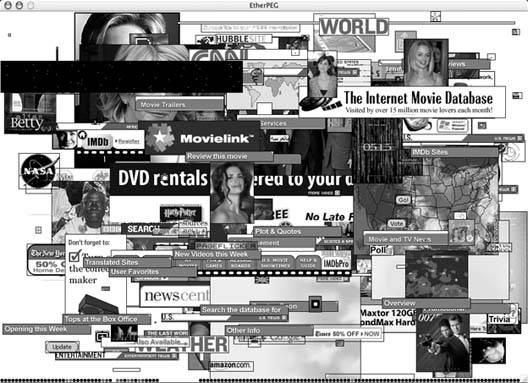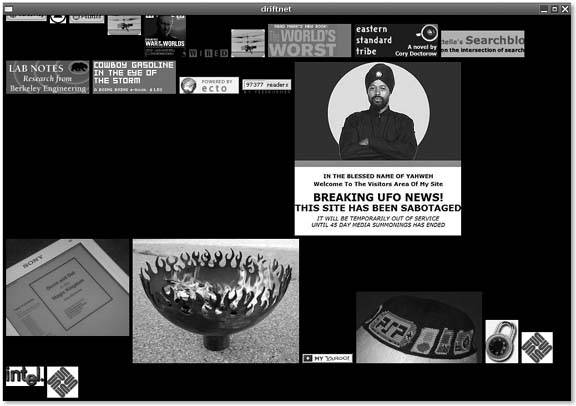Hack 41. Visualize a Network


Get a compelling visual representation of what people are looking at on your network with EtherPEG and DriftNet.
While tools such as tcpdump [Hack #33] or Ethereal [Hack #31] give you detailed information about what people are doing on your network, the information they provide just isn't interesting to most people. They might understand that their wireless data is vulnerable to eavesdroppers, but somehow they still have an attitude of, "It's hard to do, so it won't happen to me."
For some reason, this attitude is quickly cured when people are shown the following tools. While they are really simple utilities, I think they are as revolutionary to network monitoring as the Mosaic browser was to the Internet. Rather than make logs for later analysis, they simply show you what people are looking at online, in real time.
3.3.1. EtherPEG
EtherPEG (http://www.etherpeg.org) is a clever hack for Mac OS X that combines all of the modern conveniences of a packet sniffer with the good oldfashioned friendliness of a graphics-rendering library. It watches the local network for traffic, reassembles out-of-order TCP streams, and scans the results for data that looks like a GIF or JPEG. It then simply displays that data in a random fashion in a large window. As shown in Figure 3-3, it's a real-time metabrowser that dynamically builds a view of images from other people's browsers, built up as other people look around online.
The source code and a couple compiled binaries are freely available; make sure you download the right version, at the bottom of the EtherPEG web page.
The compiled binaries for Mac OS X assume interface names of en0 or en1. If you are using other numbered interfaces, you will need to have the Xcode Tools installed and compile the source directly.
EtherPEG is decidedly not a commercial app designed for extensive eavesdropping. It is a simple but effective hack that indiscriminately shows all image data that it can assemble. It makes no attempt to display where the images have been downloaded from, or who requested them. It doesn't even save a local copy for later perusal; once you quit the app, all collected data is lost.
Figure 3-3. EtherPEG in action

If you are looking for a similar (and even more functional) application that will run on an OS other than Mac OS X, read on.
3.3.2. DriftNet
Inspired by EtherPEG, DriftNet (http://www.ex-parrot.com/~chris/driftnet) is a network image grabber for X11. In addition to decoding image files from sniffed network data, it has a couple other features. It can save all decoded images for later processing (say, by a screensaver app) and has experimental support for decoding an MPEG audio stream.
Ubuntu users can install DriftNet with an apt-get install driftnet command. Contributed RPMs are available for Fedora and Red Hat, as well as other Linux distributions. Ports are also available for FreeBSD users. The code has been tested to compile on Linux and Solaris.
As shown in Figure 3-4, DriftNet's interface is just as simple as EtherPEG. You can click on individual images to save them to disk or, if you want to save all grabbed images, start up driftnet with the -a switch. This starts DriftNet in adjunct mode, which doesn't open a window, but simply saves all image data to a temporary directory (which can also be specified with the -d switch). Other applications can then use this ever-growing collection of images as a data source for their own ends.
Figure 3-4. DriftNet in action

DriftNet has received a surprising amount of bad press as being the worst sort of spyware utility and is sometimes billed as usable only for invading other people's privacy. This is a rather specious way of looking at the capabilities of DriftNet or EtherPEG, since neither program can give you any indication where the images you grab have come from or their end user destination.
On the contrary, tools like this are tremendously useful. Not only can a systems administrator use such a tool to discourage inappropriate use of a corporate network (by simply leaving it running on a monitor in a public place), but it can also provide an amazing insight into the mood of a crowd of wireless users.
What better way to find out what is going on in the minds of wireless users than to see what they are looking at on their screens?
|
If nothing else, tools such as DriftNet and EtherPEG help to remind people of the importance of good wireless security practices and of the use of discretion when using wireless networks in general.
This sort of eavesdropping is possible only because people use insecure protocols and unknowingly broadcast their network traffic in the clear for all to hear. If you are using strong application layer encryption such as SSH or IPSec, or the modern wireless layer encryption of WPA/802.11i, this sort of tool is completely useless.
As a friend of mine says, "Running EtherPEG or DriftNet while sitting at a public wireless hotspot is analogous to looking at the covers of books and magazines people are reading."
Bluetooth, Mobile Phones, and GPS
- Hacks 122: Introduction
- Hack 1. Set Up Bluetooth on Linux
- Hack 2. Set Up Bluetooth on Windows XP
- Hack 3. Connect Mac OS X with a Bluetooth Phone
- Hack 4. Connect Linux with a Bluetooth Phone
- Hack 5. Connect Windows XP with a Bluetooth Phone
- Hack 6. Use Your Treo as a Modem
- Hack 7. Send SMS from a PowerBook
- Hack 8. Remote Control Mac OS X with Bluetooth Phones and PDAs
- Hack 9. Remote Control Linux with a Bluetooth Phone
- Hack 10. Control XMMS with Bluetooth
- Hack 11. Liven Up Parties with a Participatory Slideshow
- Hack 12. Send SMS from Linux
- Hack 13. Remote Control Windows with Bluetooth Phones and PDAs
- Hack 14. Control Your Bluetooth Phone with FMA
- Hack 15. Control Your Computer from Your Palm
- Hack 16. Control Your Home Theater from Your Palm
- Hack 17. Choose a Cellular Data Plan
- Hack 18. Blog from Your Mobile Phone
- Hack 19. Get Google Maps on Your Mobile Phone
- Hack 20. Share Your GPS
- Hack 21. Broadcast Your GPS Position
- Hack 22. Map Wi-Fi Networks with Kismet and GPSd
Network Discovery and Monitoring
- Hacks 2339: Introduction
- Hack 23. Find All Available Wireless Networks
- Hack 24. Discover Networks with NetStumbler
- Hack 25. Detect Networks with Handheld PCs
- Hack 26. Find and Join Wireless Networks with AP Radar
- Hack 27. Detect Networks on Mac OS X
- Hack 28. Scan Passively with KisMAC
- Hack 29. Detect Networks with Kismet
- Hack 30. Monitor Wireless Links in Linux with Wavemon
- Hack 31. Analyze Traffic with Ethereal
- Hack 32. Track 802.11 Frames in Ethereal
- Hack 33. Watch Network Traffic
- Hack 34. grep Your Network
- Hack 35. Check Wi-Fi Network Performance with Qcheck
- Hack 36. Estimate Network Performance
- Hack 37. Get Real-Time Network Stats
- Hack 38. Graph Your Wireless Performance
- Hack 39. Find Radio Manufacturers by MAC
Wireless Security
- Hacks 4051: Introduction
- Hack 40. Stop Moochers from Stealing Your Wi-Fi Bandwidth
- Hack 41. Visualize a Network
- Hack 42. Secure Your Linux Network with WPA
- Hack 43. Control Wireless Access by MAC
- Hack 44. Authenticate Wireless Users
- Hack 45. Forward Ports over SSH
- Hack 46. Proxy Web Traffic over SSH
- Hack 47. Securely Connect Two Networks
- Hack 48. Generate a Tunnel Configuration Automatically
- Hack 49. Poll Wireless Clients
- Hack 50. Interrogate the Network
- Hack 51. Track Wireless Users
Hardware Hacks
- Hacks 5262: Introduction
- Hack 52. Add an External Antenna
- Hack 53. Do-It-Yourself Access Point Hardware
- Hack 54. Boot from a Compact Flash Hard Drive
- Hack 55. Increase the Range of a PowerBook
- Hack 56. Send Power over Your Ethernet
- Hack 57. The NoCat Night Light
- Hack 58. Upgrade the Linksys WET11
- Hack 59. Scan for Wireless Networks Automatically
- Hack 60. Backlight Your Zipit
- Hack 61. Unwire Your Pistol Mouse
- Hack 62. Mobilize Your WRT54G with the WiFiCar
Software Hacks
- Hacks 6382: Introduction
- Hack 63. Build Your Own Access Point with Linux
- Hack 64. Bridge Your Linux AP
- Hack 65. Protect Your Bridge with a Firewall
- Hack 66. Filter MAC with HostAP and Madwifi
- Hack 67. Upgrade Your Wireless Router
- Hack 68. Set Up an OLSR Mesh Network
- Hack 69. Extend Your Wireless Network with WDS
- Hack 70. Pebble
- Hack 71. Wall Off Your Wireless
- Hack 72. Run Your Mac as an Access Point
- Hack 73. Run Linux on the Zipit Wireless Messenger
- Hack 74. Capture Wireless Users with NoCatAuth
- Hack 75. Capture Wireless Users on a Small Scale
- Hack 76. Build an Online Community in Your Offline Neighborhood
- Hack 77. Manage Multiple AirPort Base Stations
- Hack 78. Advertise Bonjour Services in Linux
- Hack 79. Advertise Any Service with Bonjour in Mac OS X
- Hack 80. Redirect Brought to you by Bonjour Ads
- Hack 81. Use a Windows-Only Wireless Card in Linux
- Hack 82. Use Your Orinoco Card with Hermes AP
Do-It-Yourself Antennas
- Hacks 8393: Introduction
- Hack 83. Make a Deep Dish Cylindrical Parabolic Reflector
- Hack 84. Spider Omni Antenna
- Hack 85. Pringles Can Waveguide
- Hack 86. Pirouette Can Waveguide
- Hack 87. Primestar Dish with Waveguide Feed
- Hack 88. Primestar Dish with Biquad Feed
- Hack 89. Cut a Cable Omni Antenna
- Hack 90. Build a Slotted Waveguide Antenna
- Hack 91. The Passive Repeater
- Hack 92. Determine Your Antenna Gain
- Hack 93. Build Cheap, Effective Roof Mounts
Wireless Network Design
- Hacks 94100: Introduction
- Hack 94. Analyze Elevation Profiles for Better Long-Range Wireless Networking
- Hack 95. Build a Wireless Network for the Large House
- Hack 96. Establish Line of Sight
- Hack 97. Calculate the Link Budget
- Hack 98. Align Antennas at Long Distances
- Hack 99. Slow Down to Speed Up
- Hack 100. Take Advantage of Antenna Polarization
Appendix A. Wireless Standards
- Appendix A. Wireless Standards
- Section A.1. 802.11: The Mother of All IEEE Wireless Ethernet
- Section A.2. 802.11a: The Betamax of the 802.11 Family
- Section A.3. 802.11b: The De Facto Standard
- Section A.4. 802.11g: Like 802.11b, only Faster
- Section A.5. 802.16: WiMAX Long Distance Wireless Infrastructure
- Section A.6. Bluetooth: Cable Replacement for Devices
- Section A.7. 900 MHz: Low Speed, Better Coverage
- Section A.8. CDPD, 1xRTT, and GPRS: Cellular Data Networks
- Section A.9. FRS and GMRS: Super Walkie-Talkies
- Section A.10. 802.1x: Port Security for Network Communications
- Section A.11. WPA & 802.11i
- Section A.12. BSS Versus IBSS
Appendix B. Wireless Hardware Guide
EAN: 2147483647
Pages: 178

